Quantification of Soil Deep Drainage and Aquifer Recharge Dynamics according to Land Use and Land Cover in the Basement Zone of Burkina Faso in West Africa
Abstract
:1. Introduction
2. Materials and Methods
2.1. Study Area
2.1.1. Location and Physical Setting
2.1.2. Rainfall Regime and Climate Evolution
2.1.3. Geological Setting
2.2. Field Investigations and Data Collection
2.2.1. The Experimental Setup
2.2.2. Monitoring and Data Collection
2.2.3. Determination of the Physical and Hydraulic Parameters of Soils
2.3. Calculation of Water Balance Components
2.3.1. Rainfall (P) and Runoff (R) Analysis
2.3.2. Deep Drainage
2.3.3. Water Storage Variation
2.3.4. Water Balance and Aquifer Recharge
3. Results
3.1. Physical and Hydraulic Soil Parameters
3.2. Water Balance Components
3.3. Recharge and Transfer Mechanism in the Saturated Zone
4. Conclusions
Supplementary Materials
Author Contributions
Funding
Institutional Review Board Statement
Informed Consent Statement
Data Availability Statement
Acknowledgments
Conflicts of Interest
References
- UN. The United Nations World Water Development Report 2022: Groundwater: Making the Invisible Visible; UNESCO: Paris, France, 2022. [Google Scholar]
- Seiler, K.P.; Gat, J.R. Groundwater Recharge from Run-Off. Infiltration and Percolation; Springer Science & Business Media: Berlin/Heidelberg, Germany, 2007; Volume 55, ISBN 978-1-4020-5305-4. [Google Scholar]
- Leader, T.T.; Wijnen, M. Assessment of Groundwater Challenges & Opportunities in Support of Sustainable Development in Sub-Saharan Africa; The World Bank: Washington, DC, USA, 2018. [Google Scholar]
- Gaye, C.B.; Tindimugaya, C. Review: Challenges and Opportunities for Sustainable Groundwater Management in Africa. Hydrogeol. J. 2019, 27, 1099–1110. [Google Scholar] [CrossRef]
- Simmers, I. Aridity, Groundwater Recharge and Water Resources Management. In Groundwater Recharge: A Guide to Recharge Measurement in Arid and Semiarid Regionsunderstanding and Estimating Natural Recharge; Lerner, D.S., Issar, S.I., Eds.; Verlag Heinz Heise: Hannover, Germany, 1990. [Google Scholar]
- Belemtougri, A.P.; Ducharne, A.; Tazen, F.; Oudin, L.; Karambiri, H. Understanding Key Factors Controlling the Duration of River Flow Intermittency: Case of Burkina Faso in West Africa. J. Hydrol. Reg. Stud. 2021, 37, 100908. [Google Scholar] [CrossRef]
- Zipper, S.C.; Dallemagne, T.; Gleeson, T.; Boerman, T.C.; Hartmann, A. Groundwater Pumping Impacts on Real Stream Networks: Testing the Performance of Simple Management Tools. Water Resour. Res. 2018, 54, 5471–5486. [Google Scholar] [CrossRef] [Green Version]
- Gehrels, H. Impact of Human Activity on Groundwater Dynamics: Proceedings of an International Symposium (Symposium S3) Held during the Sixth Scientific Assembly of the International Association of Hydrological Sciences (IAHS) at Maastricht, The Netherlands, from 18 T; International Assn of Hydrological Sciences: Wallingford, UK, 2001; ISBN 1901502562. [Google Scholar]
- Tang, Z.; Engel, B.A.; Pijanowski, B.C.; Lim, K.J. Forecasting Land Use Change and Its Environmental Impact at a Watershed Scale. J. Environ. Manag. 2005, 76, 35–45. [Google Scholar] [CrossRef] [PubMed]
- Rusagara, R.; Koïta, M.; Plagnes, V.; Jost, A. Groundwater Recharge Pathways to a Weathered-Rock Aquifer System in a Dryland Catchment in Burkina Faso. Hydrogeol. J. 2022, 30, 1489–1512. [Google Scholar] [CrossRef]
- Yonaba, O.R.; Biaou, A.C.; Koïta, M.; Tazen, F.; Mounirou, L.A.; Zouré, C.O.; Queloz, P.; Karambiri, H.; Yacouba, H. A Dynamic Land Use/Land Cover Input Helps in Picturing the Sahelian Paradox: Assessing Variability and Attribution of Changes in Surface Runoff in a Sahelian Watershed. Sci. Total Environ. 2021, 757, 143792. [Google Scholar] [CrossRef] [PubMed]
- Kim, J.H.; Jackson, R.B. A Global Analysis of Groundwater Recharge for Vegetation, Climate, and Soils. Vadose Zo. J. 2012, 11, 21ra. [Google Scholar] [CrossRef] [Green Version]
- Guo, Y.; Gan, F.; Yan, B.; Bai, J.; Wang, F.; Jiang, R.; Xing, N.; Liu, Q. Evaluation of Groundwater Storage Depletion Using GRACE/GRACE Follow-On Data with Land Surface Models and Its Driving Factors in Haihe River Basin, China. Sustainability 2022, 14, 1108. [Google Scholar] [CrossRef]
- Vörösmarty, C.J.; Green, P.; Salisbury, J.; Lammers, R.B. Global Water Resources: Vulnerability from Climate Change and Population Growth. Science 2000, 289, 284–288. [Google Scholar] [CrossRef] [Green Version]
- Keese, K.E.; Scanlon, B.R.; Reedy, R.C. Assessing Controls on Diffuse Groundwater Recharge Using Unsaturated Flow Modeling. Water Resour. Res. 2005, 41, 1–12. [Google Scholar] [CrossRef]
- Owuor, S.O.; Butterbach-Bahl, K.; Guzha, A.C.; Jacobs, S.; Merbold, L.; Rufino, M.C.; Pelster, D.E.; Díaz-Pinés, E.; Breuer, L. Conversion of Natural Forest Results in a Significant Degradation of Soil Hydraulic Properties in the Highlands of Kenya. Soil Tillage Res. 2018, 176, 36–44. [Google Scholar] [CrossRef] [Green Version]
- Pielke, R.A.; Avissar, R.; Raupach, M.; Dolman, A.J.; Zeng, X.; Denning, A.S. Interactions between the Atmosphere and Terrestrial Ecosystems: Influence on Weather and Climate. Glob. Chang. Biol. 1998, 4, 461–475. [Google Scholar] [CrossRef]
- Pitman, A.J.; Narisma, G.T.; Pielke, R.A.; Holbrook, N.J. Impact of Land Cover Change on the Climate of Southwest Western Australia. J. Geophys. Res. Atmos. 2004, 109, 1–12. [Google Scholar] [CrossRef] [Green Version]
- Scanlon, B.R.; Reedy, R.C.; Stonestrom, D.A.; Prudic, D.E.; Dennehy, K.F. Impact of Land Use and Land Cover Change on Groundwater Recharge and Quality in the Southwestern US. Glob. Chang. Biol. 2005, 11, 1577–1593. [Google Scholar] [CrossRef]
- Fayer, M.J.; Gee, G.W.; Rockhold, M.L.; Freshley, M.D.; Walters, T.B. Estimating Recharge Rates for a Groundwater Model Using a GIS. J. Environ. Qual. 1996, 25, 510–518. [Google Scholar] [CrossRef]
- Rockhold, M.L.; Fayer, M.J.; Kincaid, C.T.; Gee, G.W. Estimation of Natural Ground Water Recharge for the Performance Assessment of a Low-Level Waste Disposal Facility at the Hanford Site; U.S. Department of Energy Office of Scientific and Technical Information: Oak Ridge, TN, USA, 1995; p. 93. [Google Scholar] [CrossRef] [Green Version]
- Scanlon, B.R.; Reedy, R.C.; Bronson, K.F. Impacts of Land Use Change on Nitrogen Cycling Archived in Semiarid Unsaturated Zone Nitrate Profiles, Southern High Plains, Texas. Environ. Sci. Technol. 2008, 42, 7566–7572. [Google Scholar] [CrossRef]
- Huang, T.; Pang, Z.; Edmunds, W.M. Soil Profile Evolution Following Land-Use Change: Implications for Groundwater Quantity and Quality. Hydrol. Process. 2013, 27, 1238–1252. [Google Scholar] [CrossRef]
- Zouré, C.O.; Queloz, P.; Koïta, M.; Niang, D.; Fowé, T.; Yonaba, O.R.; Consuegra, D.; Yacouba, H.; Karambiri, H. Modelling the Water Balance on Farming Practices at Plot Scale: Case Study of Tougou Watershed in Northern Burkina Faso. Catena 2019, 173, 59–70. [Google Scholar] [CrossRef] [Green Version]
- Dams, J.; Woldeamlak, S.T.; Batelaan, O. Predicting Land-Use Change and Its Impact on the Groundwater System of the Kleine Nete Catchment, Belgium. Hydrol. Earth Syst. Sci. 2008, 12, 1369–1385. [Google Scholar] [CrossRef]
- Ibrahim, M.; Favreau, G.; Scanlon, B.R.; Seidel, J.L.; Le Coz, M.; Demarty, J.; Cappelaere, B. Long-Term Increase in Diffuse Groundwater Recharge Following Expansion of Rainfed Cultivation in the Sahel, West Africa. Hydrogeol. J. 2014, 22, 1293–1305. [Google Scholar] [CrossRef]
- Prabhakar, A.; Tiwari, H. Land Use and Land Cover Effect on Groundwater Storage. Model. Earth Syst. Environ. 2015, 1, 45. [Google Scholar] [CrossRef] [Green Version]
- Ashaolu, E.; Ifabiyi, I. Effect of Land Use/Land Cover Change on Groundwater Recharge in Osun Drainage Basin, Nigeria. J. Geol. Geogr. Geoecology 2019, 28, 381–394. [Google Scholar] [CrossRef]
- Mengistu, T.D.; Chung, I.-M.; Kim, M.-G.; Chang, S.W.; Lee, J.E. Impacts and Implications of Land Use Land Cover Dynamics on Groundwater Recharge and Surface Runoff in East African Watershed. Water 2022, 14, 2068. [Google Scholar] [CrossRef]
- Abdelaziz, K.K.; Nicaise, Y.; Séguis, L.; Ouattara, I.; Moussa, O.; Auguste, K.; Kamagaté, B.; Diakaria, K. Influence of Land Use Land Cover Change on Groundwater Recharge in the Continental Terminal Area of Abidjan, Ivory Coast. J. Water Resour. Prot. 2020, 12, 431–453. [Google Scholar] [CrossRef]
- Hall, B.; Currell, M.; Webb, J. Using Multiple Lines of Evidence to Map Groundwater Recharge in a Rapidly Urbanising Catchment: Implications for Future Land and Water Management. J. Hydrol. 2020, 580, 124265. [Google Scholar] [CrossRef]
- Warku, F.; Korme, T.; Wedajo, G.K.; Nedow, D. Impacts of Land Use/Cover Change and Climate Variability on Groundwater Recharge for Upper Gibe Watershed, Ethiopia. Sustain. Water Resour. Manag. 2021, 8, 2. [Google Scholar] [CrossRef]
- Beekman, H.E.; Gieske, A.S.M.; Selaolo, E.T. GRES: Groundwater Recharge Studies in Botswana 1987–1996. Botswana J. Earth Sci. 1996, III, 1–17. [Google Scholar]
- Healy, R.W. Estimating Groundwater Recharge; Cambridge University Press: Cambridge, UK, 2010; ISBN 1139491393. [Google Scholar]
- Wang, L.; O Dochartaigh, B.; Macdonald, D. A Literature Review of Recharge Estimation and Groundwater Resource Assessment in Africa; British Geological Survey: London, UK, 2010. [Google Scholar]
- Gbohoui, Y.P.; Paturel, J.-E.; Fowe Tazen; Mounirou, L.A.; Yonaba, R.; Karambiri, H.; Yacouba, H. Impacts of Climate and Environmental Changes on Water Resources: A Multi-Scale Study Based on Nakanbé Nested Watersheds in West African Sahel. J. Hydrol. Reg. Stud. 2021, 35, 100828. [Google Scholar] [CrossRef]
- BUNASOLS. Rapport D’inspection Morphopédologique et Résultats d’analyses Granulométriques Des Prélèvements Des Sols Du Site Expérimental de Sanon; BUNASOLS: Ouagadougou, Burkina Faso, 2020. [Google Scholar]
- Kafando, M.B.; Koïta, M.; Le Coz, M.; Yonaba, O.R.; Fowe, T.; Zouré, C.O.; Faye, M.D.; Leye, B. Use of Multidisciplinary Approaches for Groundwater Recharge Mechanism Characterization in Basement Aquifers: Case of Sanon Experimental Catchment in Burkina Faso. Water 2021, 13, 3216. [Google Scholar] [CrossRef]
- Soro, D.D.; Koïta, M.; Biaou, C.A.; Outoumbe, E.; Vouillamoz, J.M.; Yacouba, H.; Guérin, R. Geophysical Demonstration of the Absence of Correlation between Lineaments and Hydrogeologically Usefull Fractures: Case Study of the Sanon Hard Rock Aquifer (Central Northern Burkina Faso). J. African Earth Sci. 2017, 129, 842–852. [Google Scholar] [CrossRef]
- IGB. Base de Données d’Occupation Des Terres (BDOT) 2012; IGB: Ouagadougou, Burkina Faso, 2012. [Google Scholar]
- UNEP. World Atlas of Desertification, 2nd ed.; UNEP: Nairobi, Kenya, 1997. [Google Scholar]
- ANAM. Bases de Données Météorologiques Du Burkina Faso; ANAM-BF: Ouagadougou, Burkina Faso, 2022. [Google Scholar]
- Feybesse, J.-L.; Billa, M.; Guerrot, C.; Duguey, E.; Lescuyer, J.-L.; Milesi, J.-P.; Bouchot, V. The Paleoproterozoic Ghanaian Province: Geodynamic Model and Ore Controls, Including Regional Stress Modeling. Precambrian Res. 2006, 149, 149–196. [Google Scholar] [CrossRef]
- Castaing, C.; Chevremont, P.; Donzeau, M.; Egal, E.; Le Mentour, J.; Thiéblemont, D.; Tegyey, M.; Guerrot, C.; Billa, M.; Itard, Y.; et al. Notice Explicative de La Carte Géologique et Minière Du Burkina Faso à 1/1 000 000; British Geological Survey: London, UK, 2003. [Google Scholar]
- BRGM-Aquater. Exploitation Des Eaux Souterraines En Socle Cristallin et Valorisation Agricole: Pilote Expérimental En Milieu Rural Pour Les Zones Soudano-Sahéliennes et Sahéliennes; Rapport 33576 ; BRGM (Bureau de Recherches Géologiques et Minières): Orléans, France, 1991. [Google Scholar]
- Compaore, G. Évaluation de La Fonction Capacitive Des Altérites, Site Expérimental de Sanon: Socle Granito-Gneissique Sous Climat de Type Soudano-Sahélien. Ph.D. Thesis, Université d’Avignon, Avignon, France, 1997. [Google Scholar]
- De Gramont, H.M. Amelioration de La Connaissance et de La Gestion Des Eaux Au Burkina Faso. P162723. Annexes 1: Diagnostic Sur Les Eaux Souterraines; World Bank: Washington, DC, USA, 2017. [Google Scholar]
- Soro, D.D. Caractérisation et Modélisation Hydrogéologique d’un Aquifère En Milieu de Socle Fracturé: Cas Du Site Expérimental de Sanon (Région Du Plateau Central Au Burkina Faso). Ph.D. Thesis, Université Pierre et Marie Curie, Paris, France, 2017. [Google Scholar]
- Mounirou, L.A. Etude Du Ruissellement et de L_érosion à Différentes Échelles Spatiales Sur Le Bassin Versant de Tougou En Zone Sahélienne Du Burkina Faso: Quantification et Transposition Des Données. Ph.D. Thesis, Universite de Montpellier, Montpellier, France, 2012. [Google Scholar]
- Mounirou, L.A.; Zouré, C.O.; Yonaba, O.R.; Paturel, J.-E.; Mahé, G.; Niang, D.; Yacouba, H.; Karambiri, H. Multi-Scale Analysis of Runoff from a Statistical Perspective in a Small Sahelian Catchment under Semi-Arid Climate. Arab. J. Geosci. 2020, 13, 154. [Google Scholar] [CrossRef]
- Mounirou, L.A.; Yonaba, O.R.; Koïta, M.; Paturel, J.-E.; Mahé, G.; Yacouba, H.; Karambiri, H. Hydrologic Similarity: Dimensionless Runoff Indices across Scales in a Semi-Arid Catchment. J. Arid Environ. 2021, 193, 104590. [Google Scholar] [CrossRef]
- Schaap, M.G.; Leij, F.J.; Van Genuchten, M.T. Rosetta: A Computer Program for Estimating Soil Hydraulic Parameters with Hierarchical Pedotransfer Functions. J. Hydrol. 2001, 251, 163–176. [Google Scholar] [CrossRef]
- Peugeot, C. Influence de l’encroutement Superficiel Du Sol Sur Le Fonctionnement Hydrologique d’un Versant Sahelien (Niger). Experimentations in Situ et Modelisation. Ph.D. Thesis, Université Joseph Fourier, Grenoble, France, 1995. [Google Scholar]
- Darcy, H. Les Fontaines Publiques de La Ville de Dijon: Exposition et Application; Victor Dalmont: Paris, France, 1856. [Google Scholar]
- Simunek, J.; Sejna, M.; Van Genuchten, M.T.; Šimůnek, J.; Šejna, M.; Jacques, D.; Sakai, M. The HYDRUS-1D Software Package for Simulating the One-Dimensional Movement of Water, Heat, and Multiple Solutes in Variably-Saturated Media; University of California: Riverside, CA, USA, 1998. [Google Scholar]
- Niang, D. Fonctionnement Hydrique Des Différents Types de Placages Sableux Dans Le Sahel Burkinabé. Ph.D. Thesis, École Polytechnique Fédérale de Lausanne, Lausanne, Switzerland, 2006. [Google Scholar]
- Klaus, R.; Dourado-Neto, D.; Schwantes, A.P.; Timm, L.C. Soil Water Storage as Related to Water Balance; International Centre for Theoretical Physics: Trieste, Italy, 2013; pp. 1–12. [Google Scholar]
- Allen, R.G.; Pereira, L.S.; Raes, D.; Smith, M. FAO Irrigation and Drainage Paper No. 56; Food and Agriculture Organization of the United Nations: Rome, Italy, 1998. [Google Scholar]
- Scanlon, B.R.; Healy, R.W.; Cook, P.G. Choosing Appropriate Techniques for Quantifying Groundwater Recharge. Hydrogeol. J. 2002, 10, 18–39. [Google Scholar] [CrossRef]
- Vouillamoz, J.-M. La Caractérisation Des Aquifères Par Une Méthode Non Invasive: Les Sondages Par Résonance Magnétique Protonique. Ph.D. Thesis, Université Paris, Paris, France, 2003. [Google Scholar]
- Koïta, M.; Yonli, H.F.; Soro, D.D.; Dara, A.E.; Vouillamoz, J.M. Groundwater Storage Change Estimation Using Combination of Hydrogeophysical and Groundwater Table Fluctuation Methods in Hard Rock Aquifers. Resources 2018, 7, 5. [Google Scholar] [CrossRef] [Green Version]
- Mukhopadhyay, S.; Masto, R.E.; Tripathi, R.C.; Srivastava, N.K. Application of Soil Quality Indicators for the Phytorestoration of Mine Spoil Dumps; Elsevier Inc.: Amsterdam, The Netherlands, 2019; ISBN 9780128139134. [Google Scholar]
- Casenave, A.; Valentin, C. Les États de Surface de La Zone Sahélienne: Influence Sur l’infiltration; Orstom: Paris, France, 1989. [Google Scholar]
- Zhang, X.; Yu, X.; Wu, S.; Wei, T.; Zhang, X. Effect of Forest Vegetation on Runoff and Sediment Production in Sloping Lands of Loess Area. Front. For. China 2006, 1, 336–342. [Google Scholar] [CrossRef]
- Chen, H.; Zhang, X.; Abla, M.; Lü, D.; Yan, R.; Ren, Q.; Ren, Z.; Yang, Y.; Zhao, W.; Lin, P.; et al. Effects of Vegetation and Rainfall Types on Surface Runoff and Soil Erosion on Steep Slopes on the Loess Plateau, China. Catena 2018, 170, 141–149. [Google Scholar] [CrossRef]
- Armand, R. Étude Des États de Surface Du Sol et de Leur Dynamique Pour Différentes Pratiques de Travail Du Sol. Mise Au Point d’un Indicateur de Ruissellement. Ph.D. Thesis, Université de Strasbourg, Strasbourg, France, 2009. [Google Scholar]
- Yonaba, O.R. Dynamique Spatio-Temporelle Des États de Surface et Influence Sur Le Ruissellement Sur Un Bassin de Type Sahélien: Cas Du Bassin de Tougou (Nord Burkina Faso); HAL: Lyon, France, 2020. [Google Scholar]
- Roose, E.J. Ruissellement et Érosion Avant et Après Défrichement En Fonction Du Type de Culture En Afrique Occidentale. Cah. ORSTOM Série Pédologie 1983, 20, 327–339. [Google Scholar]
- Igbadun, H.E. Estimation of Crop Water Use of Rain-Fed Maize and Groundnut Using Mini-Lysimeters. Pacific J. Sci. Technol. 2012, 13, 527–535. [Google Scholar]
- Roose, E.J. Dynamique Actuelle de Deux Sols Ferrugineux Tropicaux Indurés Sous Sorgho et Sous Savane Soudano-Sahélienne: SARIA, Haute Volta: Synthèse Des Campagnes 1971–1974; ORSTOM: Paris, France, 1979. [Google Scholar]
- Roose, E.J. Etats de Surface Du Sol et Risques de Ruissellement et D’érosion; Centre ORS: Bankstown, Australia, 1996. [Google Scholar]
- Traore, K.; Sidibe, D.K.; Coulibaly, H.; Bayala, J. Optimizing Yield of Improved Varieties of Millet and Sorghum under Highly Variable Rainfall Conditions Using Contour Ridges in Cinzana, Mali. Agric. Food Secur. 2017, 6, 1–13. [Google Scholar] [CrossRef] [Green Version]
- Ma, B.; Ma, F.; Li, Z.; Wu, F. Effects of Soil Crust and Crop on Runoff and Erosion in Loess Plateau. Acta Agric. Scand. Sect. B Soil Plant Sci. 2014, 64, 645–656. [Google Scholar] [CrossRef]
- Akponikpe, P. Millet Response to Water and Soil Fertility Management in the Sahelian Niger: Experiments and Modeling. 2008. Available online: https://dial.uclouvain.be/pr/boreal/object/boreal:19624 (accessed on 22 September 2022).
- Klaij, M.C.; Vachaud, G. Seasonal Water Balance of a Sandy Soil in Niger Cropped with Pearl Millet, Based on Profile Moisture Measurements. Agric. Water Manag. 1992, 21, 313–330. [Google Scholar] [CrossRef] [Green Version]
- Cissé, L.; Imbernon, J.; Dancette, C. Bilan Hydrique et Minéral Sous Culture d’arachide et de Mil à l’échelle de l’hectare. In Document de Travail No 1985-5; I.S.R.A., Département Systèmes et Transfert: Dakar, Senegal, 1985. [Google Scholar]
- Koïta, M.; Yonli, H.F.; Soro, D.D.; Dara, A.E.; Vouillamoz, J.M. Taking into Account the Role of the Weathering Profile in Determining Hydrodynamic Properties of Hard Rock Aquifers. Geosciences 2017, 7, 89. [Google Scholar] [CrossRef]
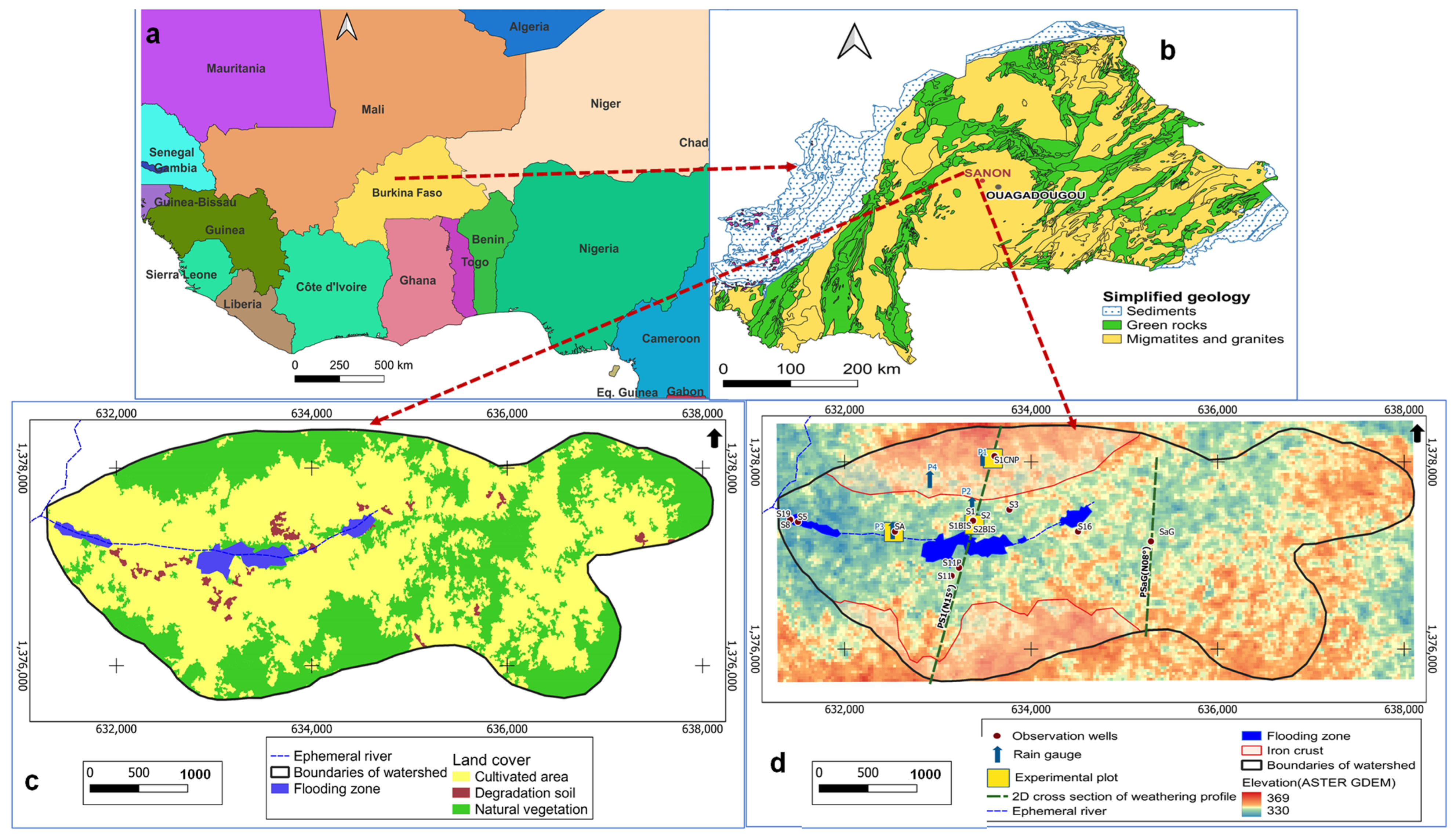
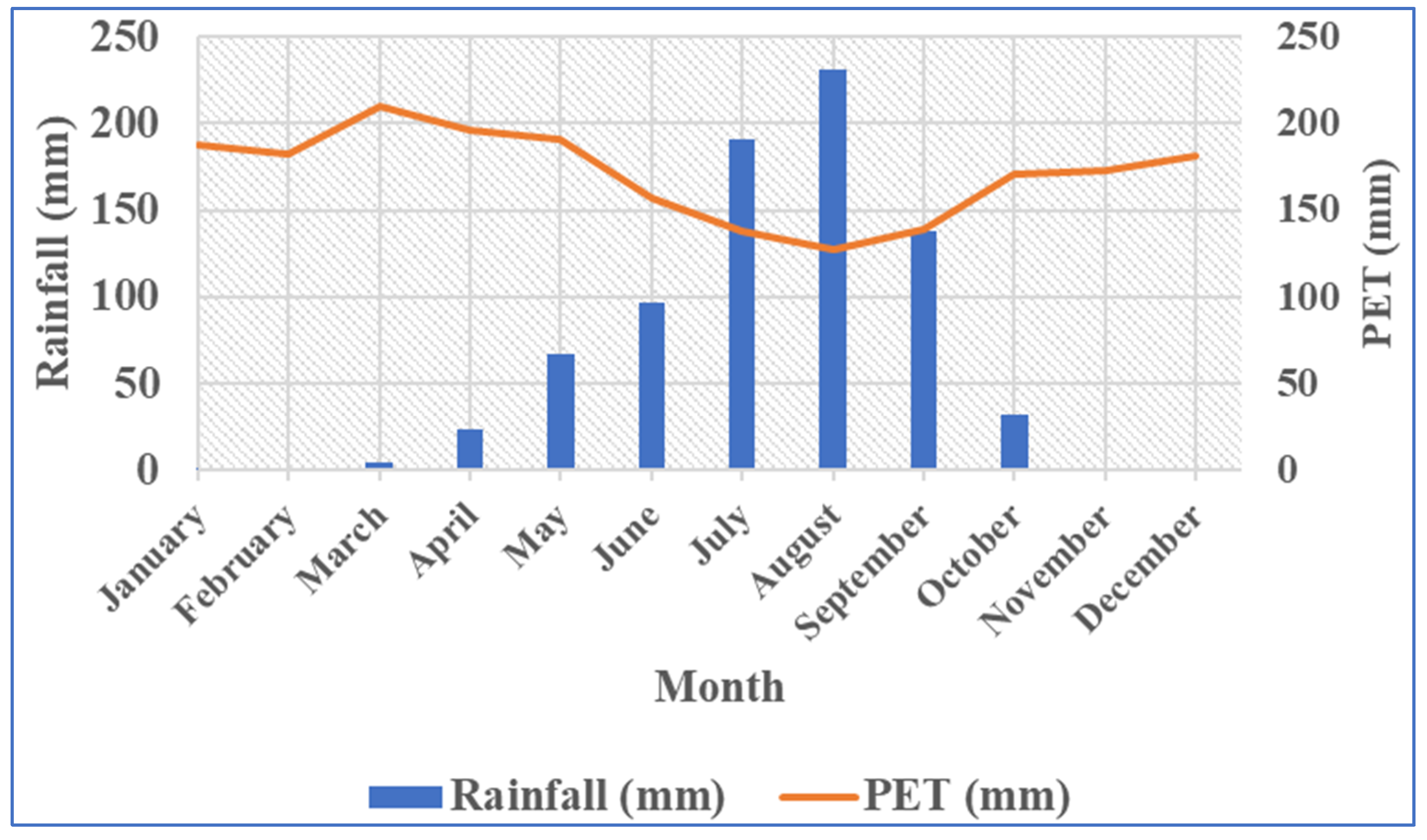
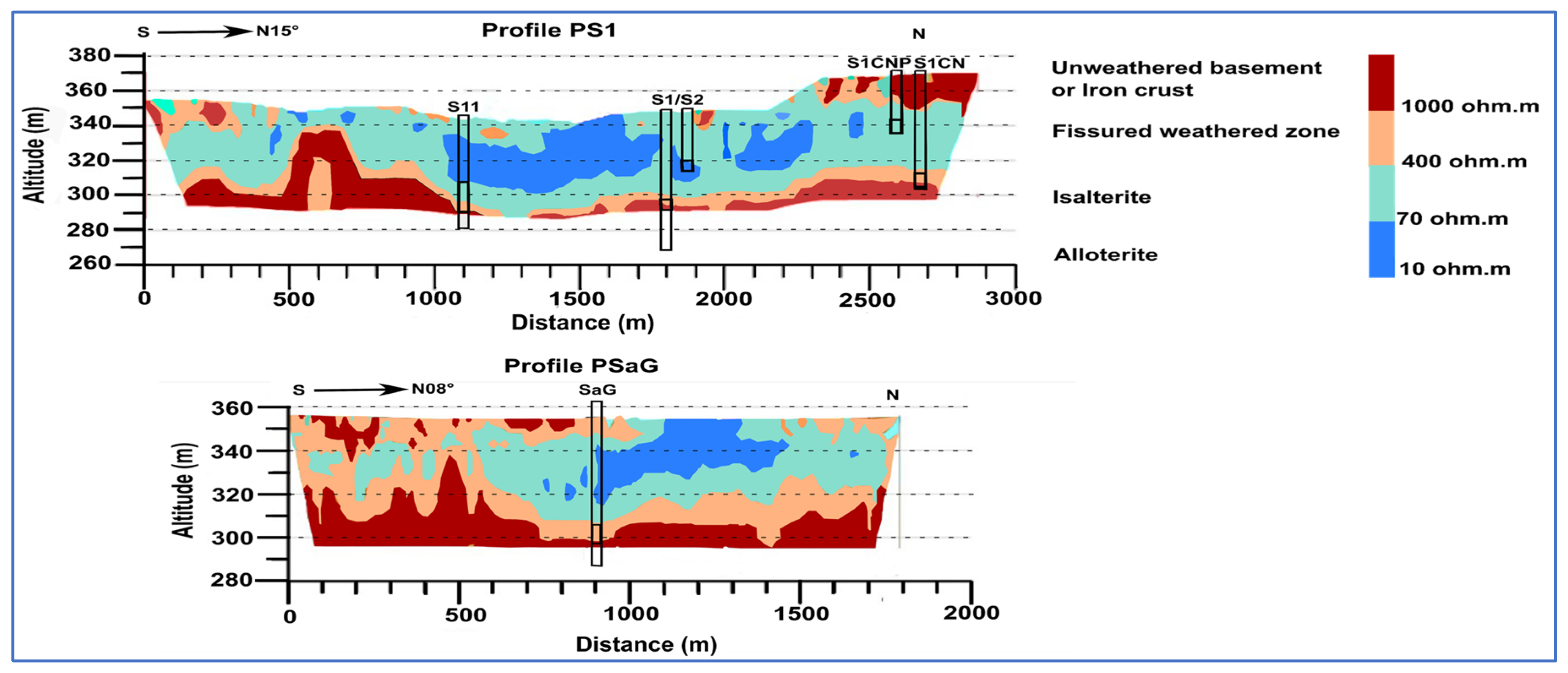
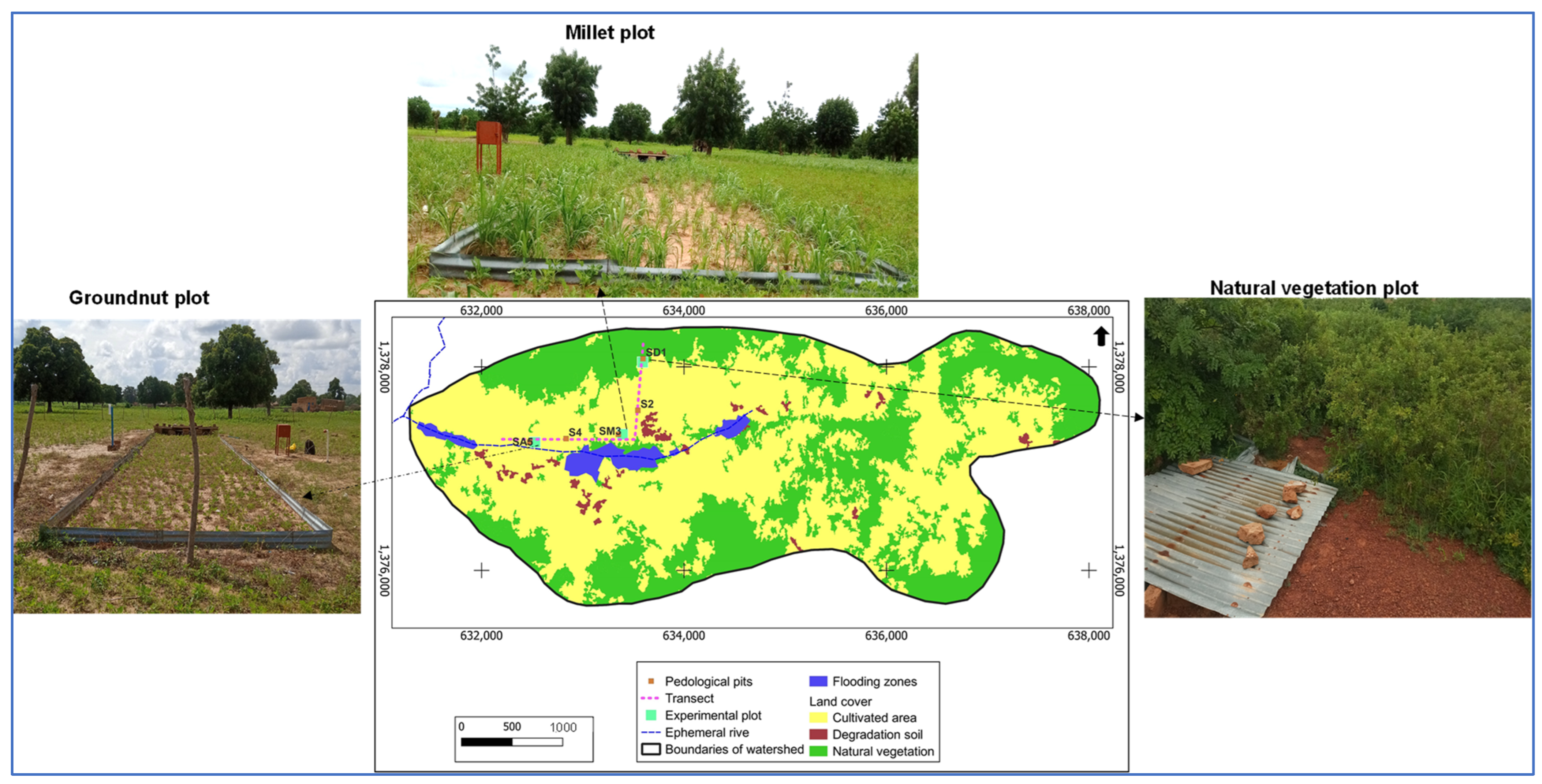
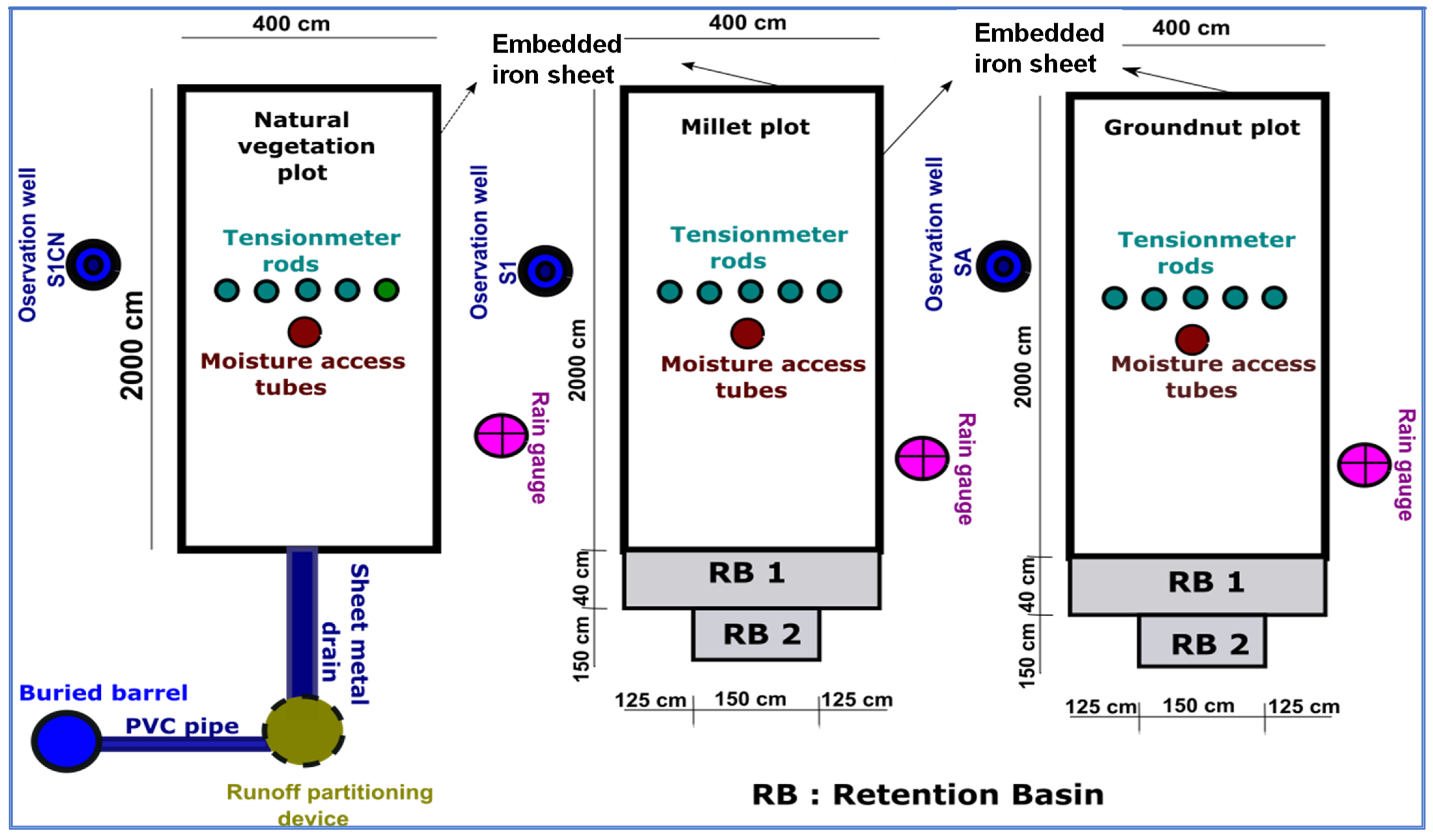
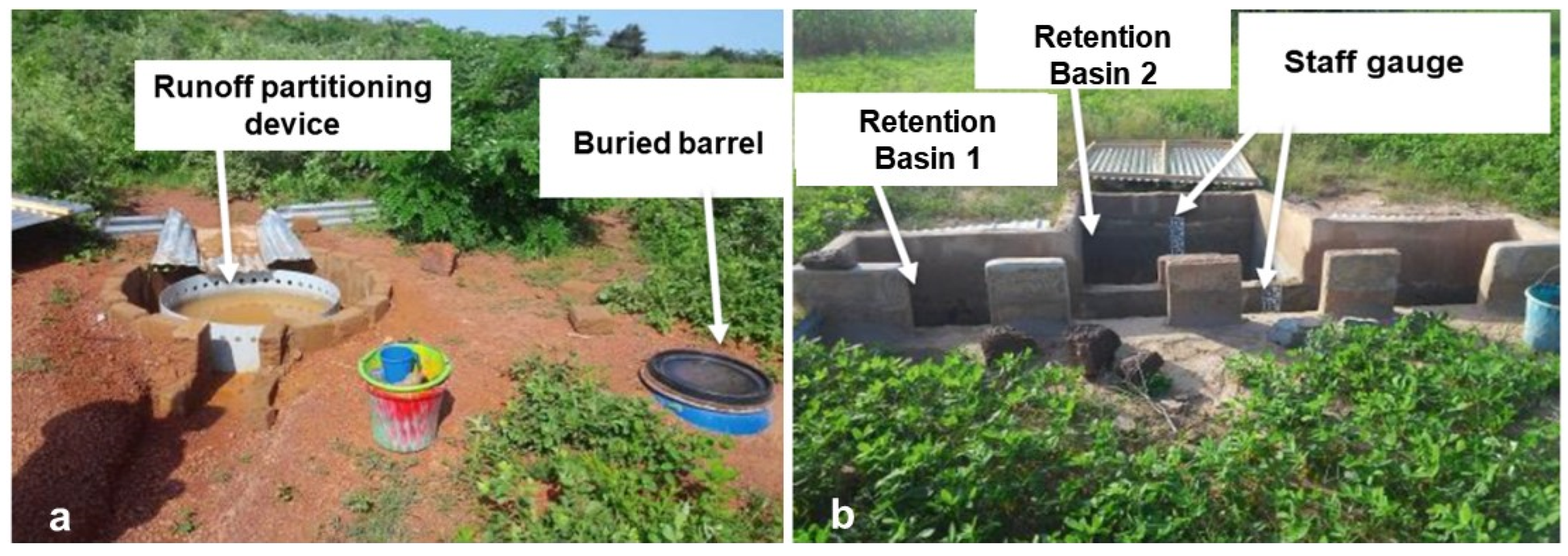
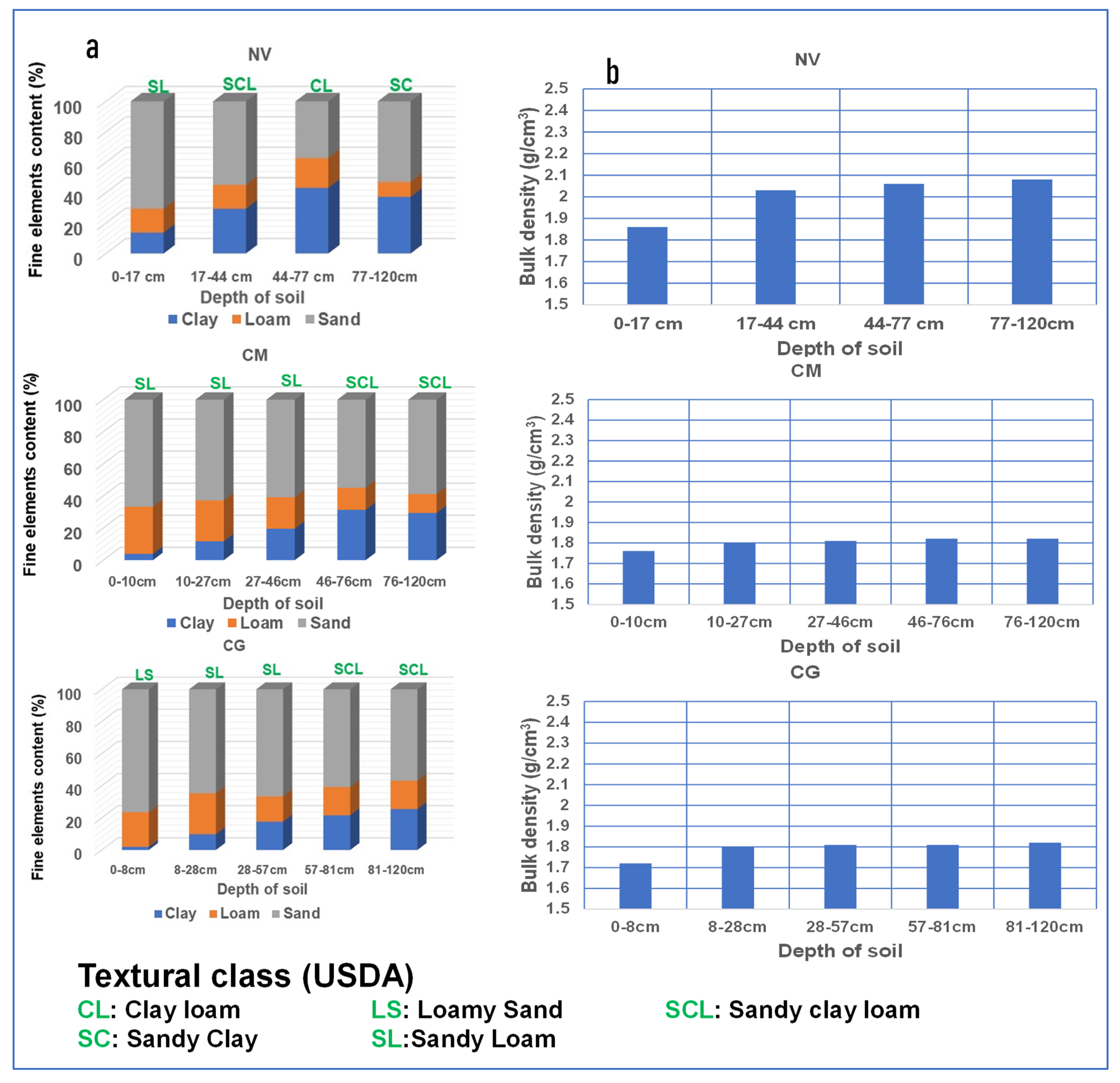
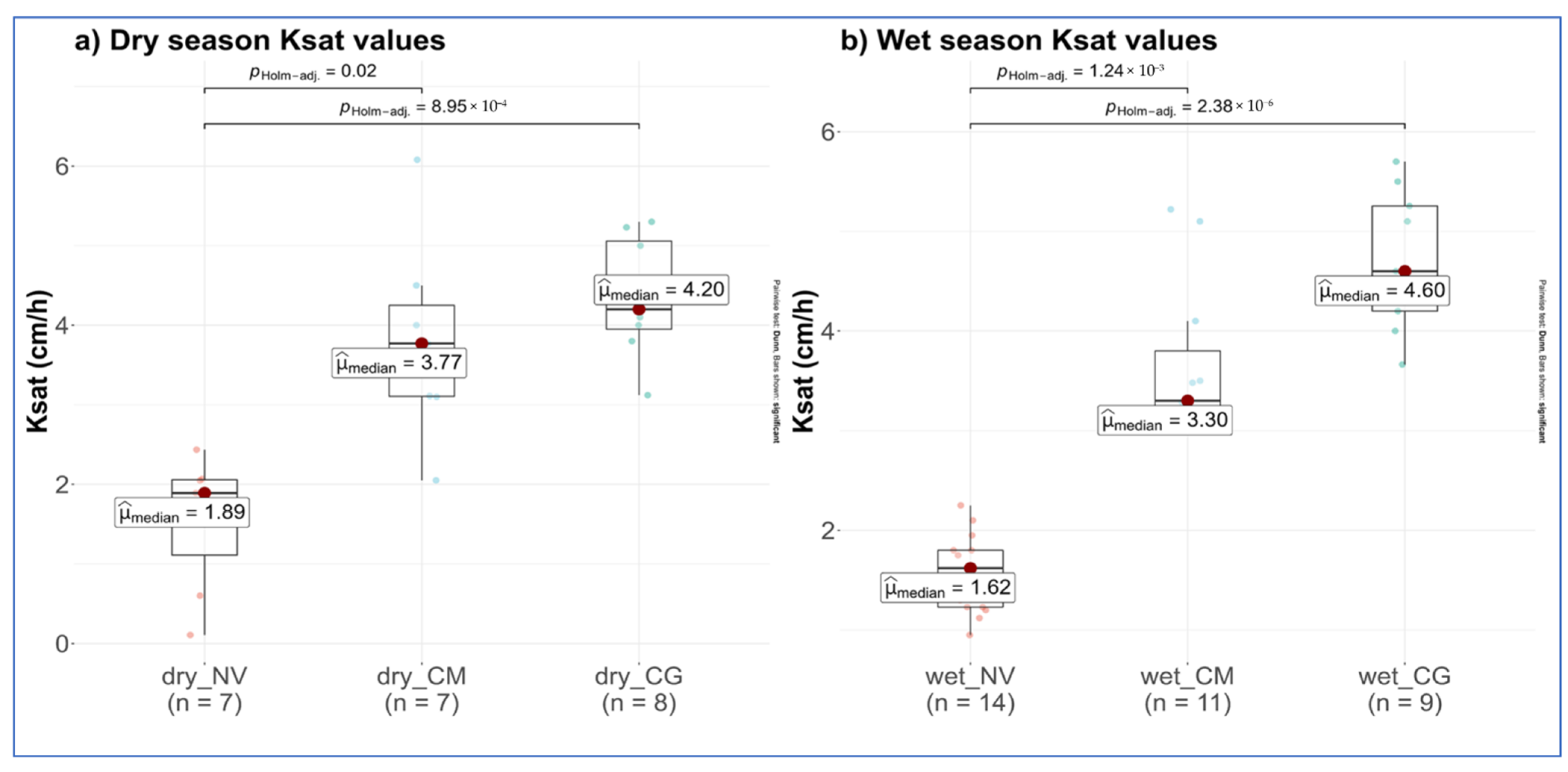


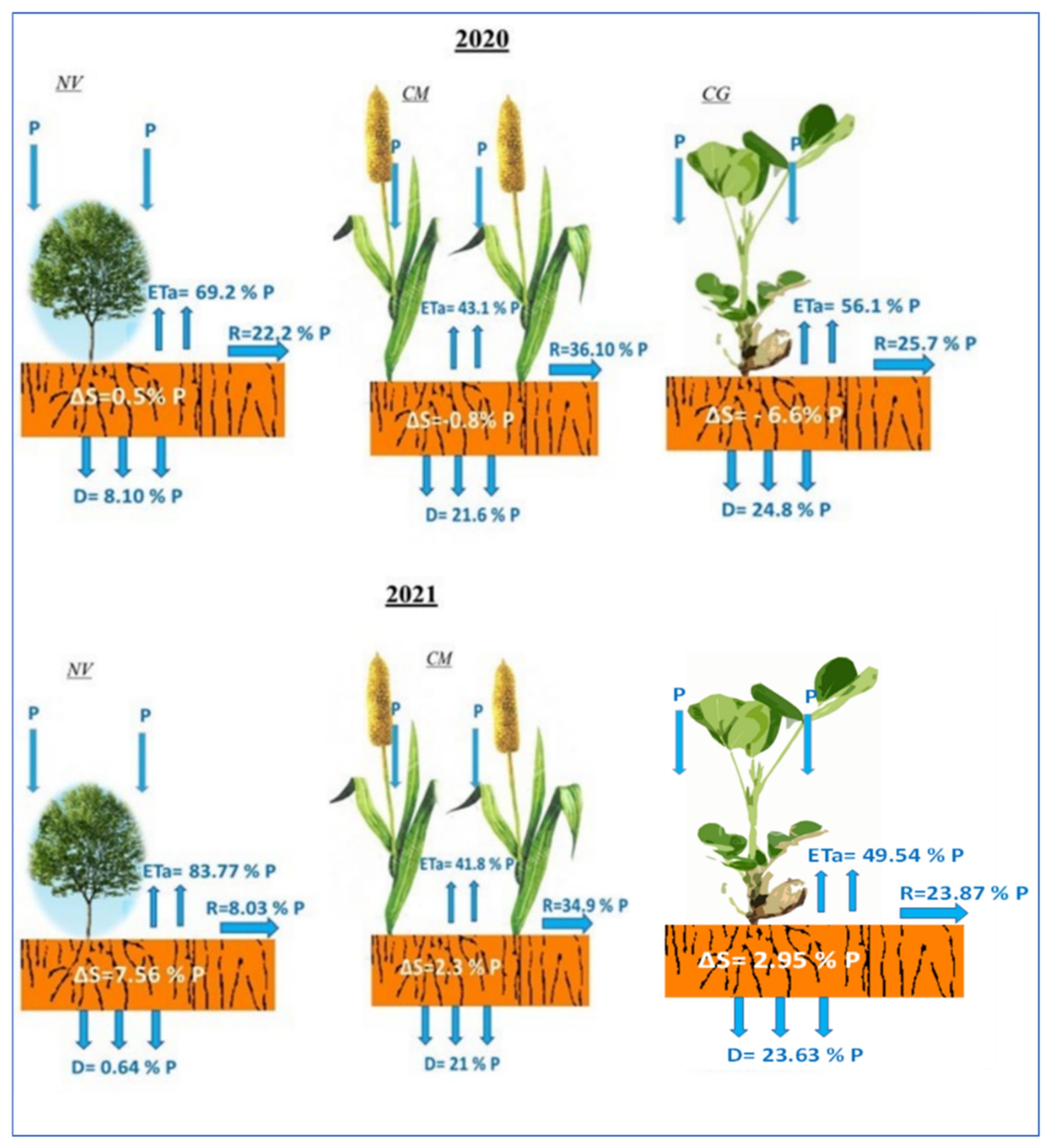
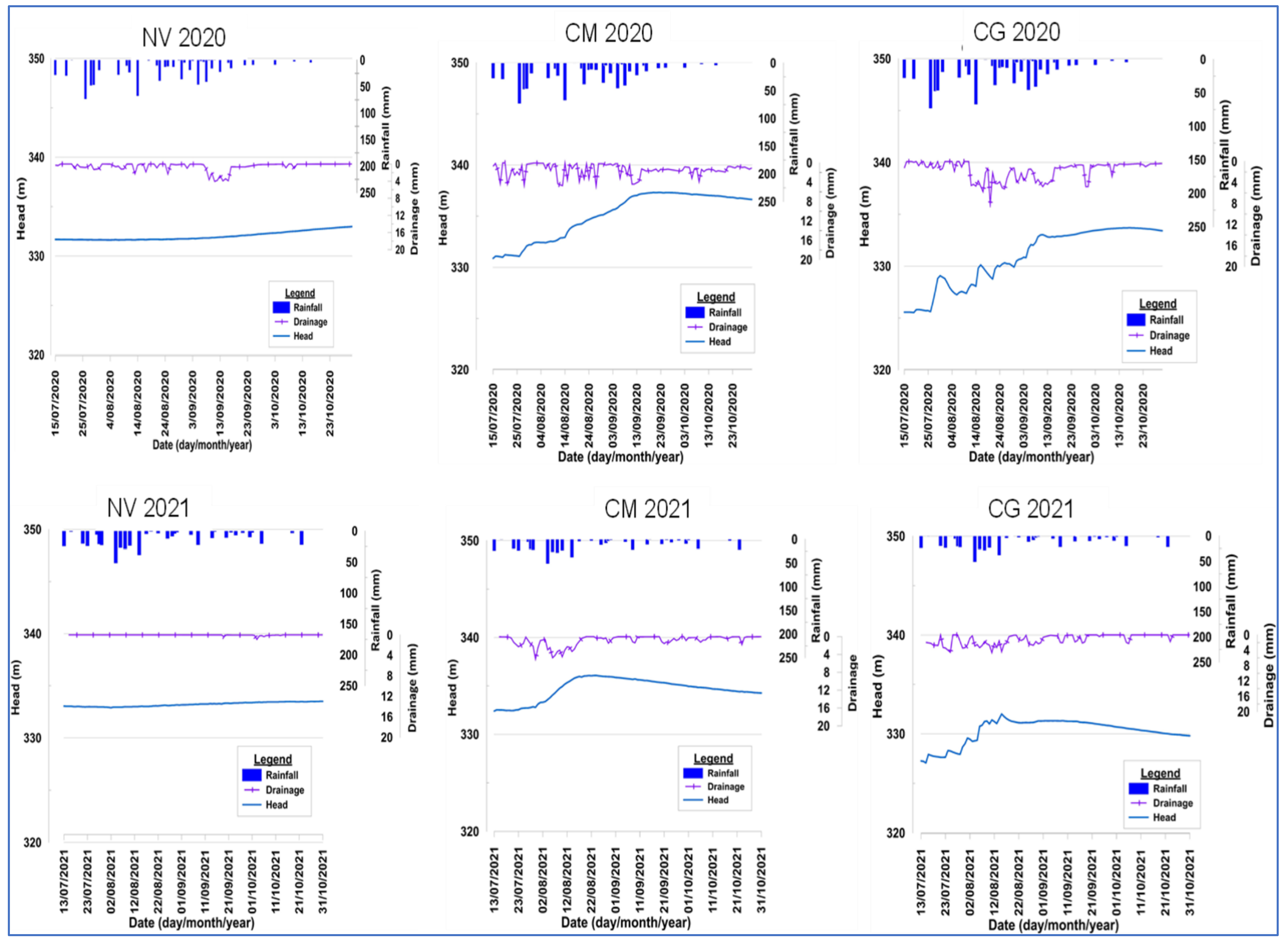
| Plot | Ksat (cm/h) | Average Clay Content (%) | |
|---|---|---|---|
| Dry Season | Wet Season | ||
| NV | 1.89 (±0.86) | 1.62 (±0.40) | 31.0 (±12.7) |
| CM | 3.77 (±1.28) | 3.30 (±0.79) | 19.2 (±11.6) |
| CG | 4.20 (±0.77) | 4.60 (±0.72) | 15.3 (±9.4) |
| Parameters | 2020 | 2021 | |
|---|---|---|---|
| Number of rainfall events | 38 | 32 | |
| Cumulative rainfall (mm) | 724 | 451.6 | |
| Number of events >30 mm | 10 | 2 | |
| Longest dry spell (in days) | 7 | 16 | |
| Cumulative runoff (mm) | NV | 159.1 | 36 |
| CM | 254.4 | 153 | |
| CG | 193.4 | 110.1 | |
| Surface rainfall/Runoff (R/P) (%) | NV | 25.5 | 8.3 |
| CM | 36.12 | 34.90 | |
| CG | 25.72 | 23.88 | |
| Parameters | 2020 | 2021 | ||||
|---|---|---|---|---|---|---|
| NV | CM | CG | NV | CM | CG | |
| P (mm) | 715.3 | 704.5 | 752.1 | 448.3 | 438.3 | 461.2 |
| R(mm) | 159.1 | 254.4 | 193.4 | 36 | 153 | 110.1 |
| D (mm) | 57.9 | 176.3 | 186.7 | 2.85 | 92 | 109 |
| ΔS (mm) | 3.6 | −5.9 | −50.1 | 33.9 | 10.3 | 13.6 |
| ETa (mm) | 494.7 | 279.7 | 422.1 | 375.55 | 183.3 | 228.5 |
| Etad (mm/d) | 4.0 | 2.4 | 3.7 | 3.4 | 1.70 | 2.1 |
| Plot | 2020 | 2021 | ||
|---|---|---|---|---|
| ETad (mm/d) | ETc (mm/d) | ETad (mm/d) | ETc (mm/d) | |
| NV | 3.80 | 4.46 | 3.4 | 4.2 |
| CM | 2.3 | 3.37 | 1.70 | 3.1 |
| CG | 3.4 | 3.9 | 2.2 | 3.3 |
| Plot | 2020 | |||||||
|---|---|---|---|---|---|---|---|---|
| Sy (%) | ΔH (m) | Re (mm) | P (mm) | D (mm) | Re/P (%) | D/P (%) | R = /D | |
| NV | - | 1.87 | 715.3 | 57 | 7.97 | |||
| CM | 2.4 | 6.44 | 154.56 | 704.5 | 165.6 | 21.94 | 23.51 | 0.93 |
| CG | 1.91 | 8.17 | 156.05 | 752.1 | 186.7 | 20.75 | 24.82 | 0.84 |
| Plot | 2021 | |||||||
| Sy (%) | ΔH (m) | R(mm) | P (mm) | D (mm) | R/P (%) | D/P (%) | R/D | |
| NV | - | 0.6 | 448.3 | 2.85 | 0.64 | |||
| CM | 2.4 | 3.68 | 88.25 | 438.3 | 95.00 | 20.13 | 21.67 | 0.93 |
| CG | 1.9 | 4.95 | 94.45 | 461.2 | 109 | 20.48 | 23.63 | 0.87 |
Publisher’s Note: MDPI stays neutral with regard to jurisdictional claims in published maps and institutional affiliations. |
© 2022 by the authors. Licensee MDPI, Basel, Switzerland. This article is an open access article distributed under the terms and conditions of the Creative Commons Attribution (CC BY) license (https://creativecommons.org/licenses/by/4.0/).
Share and Cite
Kafando, M.B.; Koïta, M.; Zouré, C.O.; Yonaba, R.; Niang, D. Quantification of Soil Deep Drainage and Aquifer Recharge Dynamics according to Land Use and Land Cover in the Basement Zone of Burkina Faso in West Africa. Sustainability 2022, 14, 14687. https://doi.org/10.3390/su142214687
Kafando MB, Koïta M, Zouré CO, Yonaba R, Niang D. Quantification of Soil Deep Drainage and Aquifer Recharge Dynamics according to Land Use and Land Cover in the Basement Zone of Burkina Faso in West Africa. Sustainability. 2022; 14(22):14687. https://doi.org/10.3390/su142214687
Chicago/Turabian StyleKafando, Moussa Bruno, Mahamadou Koïta, Cheick Oumar Zouré, Roland Yonaba, and Dial Niang. 2022. "Quantification of Soil Deep Drainage and Aquifer Recharge Dynamics according to Land Use and Land Cover in the Basement Zone of Burkina Faso in West Africa" Sustainability 14, no. 22: 14687. https://doi.org/10.3390/su142214687







